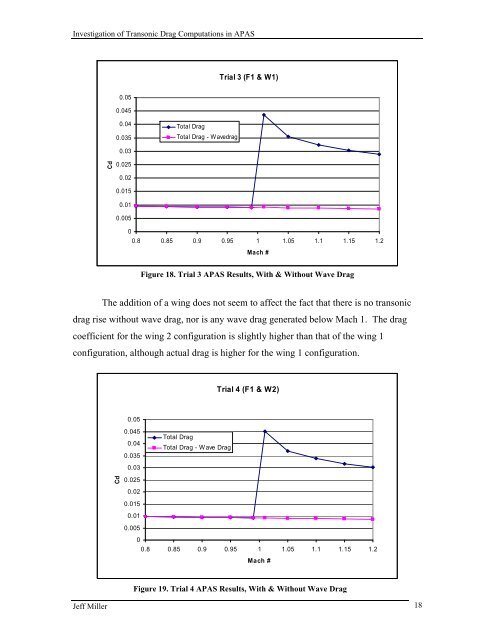Investigation of Transonic Drag Computations in Aerodynamic ...
Investigation of Transonic Drag Computations in Aerodynamic ...
Investigation of Transonic Drag Computations in Aerodynamic ...
You also want an ePaper? Increase the reach of your titles
YUMPU automatically turns print PDFs into web optimized ePapers that Google loves.
<strong>Investigation</strong> <strong>of</strong> <strong>Transonic</strong> <strong>Drag</strong> <strong>Computations</strong> <strong>in</strong> APAS<br />
Trial 3 (F1 & W1)<br />
0.05<br />
0.045<br />
0.04<br />
0.035<br />
Total <strong>Drag</strong><br />
Total <strong>Drag</strong> - W avedrag<br />
0.03<br />
Cd<br />
0.025<br />
0.02<br />
0.015<br />
0.01<br />
0.005<br />
0<br />
0.8 0.85 0.9 0.95 1 1.05 1.1 1.15 1.2<br />
Mach #<br />
Figure 18. Trial 3 APAS Results, With & Without Wave <strong>Drag</strong><br />
The addition <strong>of</strong> a w<strong>in</strong>g does not seem to affect the fact that there is no transonic<br />
drag rise without wave drag, nor is any wave drag generated below Mach 1. The drag<br />
coefficient for the w<strong>in</strong>g 2 configuration is slightly higher than that <strong>of</strong> the w<strong>in</strong>g 1<br />
configuration, although actual drag is higher for the w<strong>in</strong>g 1 configuration.<br />
Trial 4 (F1 & W2)<br />
Cd<br />
0.05<br />
0.045<br />
Total <strong>Drag</strong><br />
0.04<br />
Total <strong>Drag</strong> - Wave <strong>Drag</strong><br />
0.035<br />
0.03<br />
0.025<br />
0.02<br />
0.015<br />
0.01<br />
0.005<br />
0<br />
0.8 0.85 0.9 0.95 1 1.05 1.1 1.15 1.2<br />
Mach #<br />
Figure 19. Trial 4 APAS Results, With & Without Wave <strong>Drag</strong><br />
Jeff Miller 18
















